As we go along our daily
routine, do we ever stop and notice the art of
engraving? From the hand-made jewelry box on the dresser,
to the metal latticework carved on
the front door or the floral design daintily displayed
on wedding silver. These are all household items that
we may take for granted that actually have an artistic
purpose too. To engrave is to cut or incise a fine
line with a cutting tool also known as a burin or
graver, to create detail with pressure from the hand
on various metals.
Gazing back in time, you can see the importance of
such a classic art. Before man learned to extract
metals from the earth, the earliest engraved objects
were made of stone, wood, bone or hardened earth. So
true to our nature, engraving displays another aspect
of our human need for expressional outlet, a way of
depicting our daily life, adding the beauty to our
belongings that we see or feel around us. In 5th
Century BC, gold helmets were adorned with carvings of
feathers. The back of hand mirrors were engraved with
portrayals of mythology in 3rd and 4th Century BC
Greece.
In Persia, some
household objects were shaped as animals such as a
vase in the form of a fish incised with intricate
scale detail.
 With the onset of an alphabetical system,
philosophical adages and memorial events were also
immortalized on metal. Engraving played a important
part in religious practices, 12th Century Romanesque
portable altars gave symbolism to their beliefs. Also
in Biblical times, it is stated that a seal was
engraved on a sacred medallion which read “Holy to the
Lord”, Exodus 39:30. Engraving reached its peak in the
15th Century, when it was crucial to soldiers in
battle, being covered head to toe with metal armor, to
identify themselves with which alliance they stood
for. A family crest or Heraldic
With the onset of an alphabetical system,
philosophical adages and memorial events were also
immortalized on metal. Engraving played a important
part in religious practices, 12th Century Romanesque
portable altars gave symbolism to their beliefs. Also
in Biblical times, it is stated that a seal was
engraved on a sacred medallion which read “Holy to the
Lord”, Exodus 39:30. Engraving reached its peak in the
15th Century, when it was crucial to soldiers in
battle, being covered head to toe with metal armor, to
identify themselves with which alliance they stood
for. A family crest or Heraldic
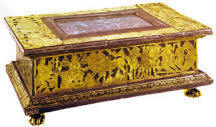 emblem
was also of high importance, showing status in a
society to announce what possessions one owned and
different designs symbolizing the joining of families
through marriage. In the 1800’s, engraving was used to
make print copies of painting masterworks to sell and
distribute commercially. The process of engraving now,
essentially uses the same technical processes of
ancient times, but survives largely in a few
specialized fields, such as weaponry, jewelry, and
musical instruments. For industrial uses and large
scale engraving, like on Intaglio plates, hand
engraving was replaced with milling machines that can
be controlled by hand or computer.
emblem
was also of high importance, showing status in a
society to announce what possessions one owned and
different designs symbolizing the joining of families
through marriage. In the 1800’s, engraving was used to
make print copies of painting masterworks to sell and
distribute commercially. The process of engraving now,
essentially uses the same technical processes of
ancient times, but survives largely in a few
specialized fields, such as weaponry, jewelry, and
musical instruments. For industrial uses and large
scale engraving, like on Intaglio plates, hand
engraving was replaced with milling machines that can
be controlled by hand or computer.
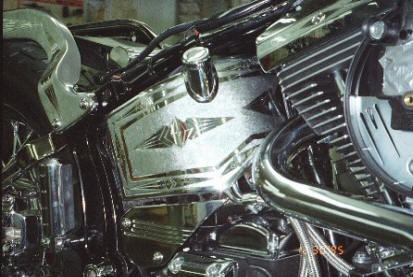
Recently there has been a revival of sorts, this
hidden art has caught the attention of the motorcycle
world and found a new place to call home. The timeless
old school charm and personalizing characteristic
makes perfect sense. For many motorcyclist, engraving
has become their favorite pastime.
Engraver, Tira Mitchell, can truly attest to this.
Encompassed in the arts all her life - studying
classical music at the Boston University School of
Fine Arts, then changing careers from computer
programmer to mother - Tira found a career suited to
her passion for the arts and her family: engraving.
Beginning with filigree patterns on eggshells and then
eventually progressing to motorcycles. Tira’s teacher
couldn’t figure out why on earth she would want to
engrave motorcycles. But we know why…
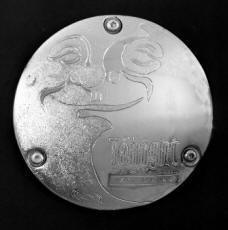 motorcycles are the new medium for artistic
expression. Due to her perseverance in her desire to
work with the iron horse, she approached the "man in
charge" at
Fairfield Cycle Center, Mike Huffman, and with a smile
was soon put to work. The first bike she branded was
the Avalon, a soft tail Harley art- deco diamond
design. The clean lines and consistent detail incised
provided that complete touch. The next Harley
motorcycle on her list was a theme bike dedicated to
the one and only Marilyn Monroe dubbed “Norma Jean,”
of course! This curvy red and white beauty showcased a
special little feature, Tira engraved Norma Jean’s
actual signature right on the tank dashboard. It’s
hard to keep this special kind of talent under wraps,
soon she was engraving for others, even a few
celebrities such as a derby cover award for Jay
Leno, a handlebar clamp cover for talk show host
Ken Hamblin. Another high visibility project was the
derby cover for the Gibson Guitar Bike designed
by Donnie Smith on display at Daytona 2004. It doesn’t
surprise us that rocker James Hetfield of Metallica,
would want his Harley engraved with the stoic iron
crosses and personalized belt guard with his custom
Harley’s name “Saga” on it, which has been cruising
the pages of EasyRider and V-Twin
magazines, in all its iron glory.
motorcycles are the new medium for artistic
expression. Due to her perseverance in her desire to
work with the iron horse, she approached the "man in
charge" at
Fairfield Cycle Center, Mike Huffman, and with a smile
was soon put to work. The first bike she branded was
the Avalon, a soft tail Harley art- deco diamond
design. The clean lines and consistent detail incised
provided that complete touch. The next Harley
motorcycle on her list was a theme bike dedicated to
the one and only Marilyn Monroe dubbed “Norma Jean,”
of course! This curvy red and white beauty showcased a
special little feature, Tira engraved Norma Jean’s
actual signature right on the tank dashboard. It’s
hard to keep this special kind of talent under wraps,
soon she was engraving for others, even a few
celebrities such as a derby cover award for Jay
Leno, a handlebar clamp cover for talk show host
Ken Hamblin. Another high visibility project was the
derby cover for the Gibson Guitar Bike designed
by Donnie Smith on display at Daytona 2004. It doesn’t
surprise us that rocker James Hetfield of Metallica,
would want his Harley engraved with the stoic iron
crosses and personalized belt guard with his custom
Harley’s name “Saga” on it, which has been cruising
the pages of EasyRider and V-Twin
magazines, in all its iron glory.
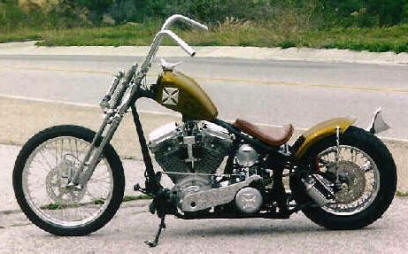
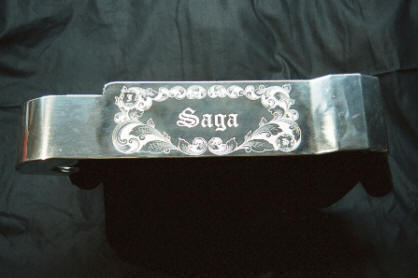
Tira Mitchell’s engraving isn’t strictly for
motorcycles. Her talents range from corvette spinners,
pipe wrenches, firearms and 40lb firehouse brass
bells. She has also expanded her ability and soon will
begin bulino engraving, which is a dot technique used
to reproduce wildlife and landscape scenes on metal.
For more information about Tira, go to:
www.engraver.com
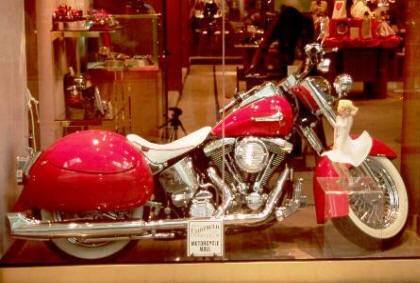

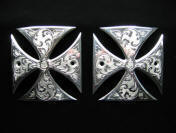
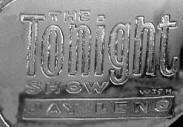
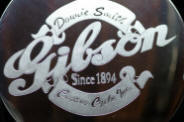
 Tira
Mitchell
Tira
Mitchell With the onset of an alphabetical system,
philosophical adages and memorial events were also
immortalized on metal. Engraving played a important
part in religious practices, 12th Century Romanesque
portable altars gave symbolism to their beliefs. Also
in Biblical times, it is stated that a seal was
engraved on a sacred medallion which read “Holy to the
Lord”, Exodus 39:30. Engraving reached its peak in the
15th Century, when it was crucial to soldiers in
battle, being covered head to toe with metal armor, to
identify themselves with which alliance they stood
for. A family crest or Heraldic
With the onset of an alphabetical system,
philosophical adages and memorial events were also
immortalized on metal. Engraving played a important
part in religious practices, 12th Century Romanesque
portable altars gave symbolism to their beliefs. Also
in Biblical times, it is stated that a seal was
engraved on a sacred medallion which read “Holy to the
Lord”, Exodus 39:30. Engraving reached its peak in the
15th Century, when it was crucial to soldiers in
battle, being covered head to toe with metal armor, to
identify themselves with which alliance they stood
for. A family crest or Heraldic
 emblem
was also of high importance, showing status in a
society to announce what possessions one owned and
different designs symbolizing the joining of families
through marriage. In the 1800’s, engraving was used to
make print copies of painting masterworks to sell and
distribute commercially. The process of engraving now,
essentially uses the same technical processes of
ancient times, but survives largely in a few
specialized fields, such as weaponry, jewelry, and
musical instruments. For industrial uses and large
scale engraving, like on Intaglio plates, hand
engraving was replaced with milling machines that can
be controlled by hand or computer.
emblem
was also of high importance, showing status in a
society to announce what possessions one owned and
different designs symbolizing the joining of families
through marriage. In the 1800’s, engraving was used to
make print copies of painting masterworks to sell and
distribute commercially. The process of engraving now,
essentially uses the same technical processes of
ancient times, but survives largely in a few
specialized fields, such as weaponry, jewelry, and
musical instruments. For industrial uses and large
scale engraving, like on Intaglio plates, hand
engraving was replaced with milling machines that can
be controlled by hand or computer. 
 motorcycles are the new medium for artistic
expression. Due to her perseverance in her desire to
work with the iron horse, she approached the "man in
charge" at
Fairfield Cycle Center, Mike Huffman, and with a smile
was soon put to work. The first bike she branded was
the Avalon, a soft tail Harley art- deco diamond
design. The clean lines and consistent detail incised
provided that complete touch. The next Harley
motorcycle on her list was a theme bike dedicated to
the one and only Marilyn Monroe dubbed “Norma Jean,”
of course! This curvy red and white beauty showcased a
special little feature, Tira engraved Norma Jean’s
actual signature right on the tank dashboard. It’s
hard to keep this special kind of talent under wraps,
soon she was engraving for others, even a few
celebrities such as a derby cover award for Jay
Leno, a handlebar clamp cover for talk show host
Ken Hamblin. Another high visibility project was the
derby cover for the Gibson Guitar Bike designed
by Donnie Smith on display at Daytona 2004. It doesn’t
surprise us that rocker James Hetfield of Metallica,
would want his Harley engraved with the stoic iron
crosses and personalized belt guard with his custom
Harley’s name “Saga” on it, which has been cruising
the pages of EasyRider and V-Twin
magazines, in all its iron glory.
motorcycles are the new medium for artistic
expression. Due to her perseverance in her desire to
work with the iron horse, she approached the "man in
charge" at
Fairfield Cycle Center, Mike Huffman, and with a smile
was soon put to work. The first bike she branded was
the Avalon, a soft tail Harley art- deco diamond
design. The clean lines and consistent detail incised
provided that complete touch. The next Harley
motorcycle on her list was a theme bike dedicated to
the one and only Marilyn Monroe dubbed “Norma Jean,”
of course! This curvy red and white beauty showcased a
special little feature, Tira engraved Norma Jean’s
actual signature right on the tank dashboard. It’s
hard to keep this special kind of talent under wraps,
soon she was engraving for others, even a few
celebrities such as a derby cover award for Jay
Leno, a handlebar clamp cover for talk show host
Ken Hamblin. Another high visibility project was the
derby cover for the Gibson Guitar Bike designed
by Donnie Smith on display at Daytona 2004. It doesn’t
surprise us that rocker James Hetfield of Metallica,
would want his Harley engraved with the stoic iron
crosses and personalized belt guard with his custom
Harley’s name “Saga” on it, which has been cruising
the pages of EasyRider and V-Twin
magazines, in all its iron glory. 

